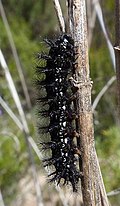| Subgenus [1] | Butterfly | Caterpillar | Species | Common name | Distribution |
|---|
| Euphydryas |  |  | Euphydryas phaeton (Drury, 1773) | Baltimore checkerspot | North America |
| Hypodryas |  |  | Euphydryas maturna (Linnaeus, 1758) | scarce fritillary | Austria, Belgium, Bulgaria, Czech Republic, Finland, France, Germany, Greece, Hungary, Kazakhstan, Lithuania, Luxembourg, Poland, Romania, Russia, Serbia and Montenegro, and Sweden. |
| | Euphydryas italica Back, Haussmann, Salk & Weiss, 2015 | | Italy |
 | | Euphydryas intermedia (Ménétriés, 1859) | | Alps, Middle and South Ural, in the taiga zone and the West Siberian Lowland, South Siberia and the Russian Far East, Sakhalin, Mongolia, Northeast China, North Korea |
| | Euphydryas ichnea (Boisduval, 1833) | | Urals to Sakhalin; the Alps, Mongolia, NE. China, Korea |
 |  | Euphydryas cynthia (Schiffermüller, 1775) | Cynthia's fritillary | Bulgaria |
 | | Euphydryas iduna (Dalman, 1816) | Lapland fritillary | Arctic Europe, Arctic Asia, Caucasus Major, Alatau, Russian Far East, Altai, Sayan |
 | | Euphydryas gillettii (Barnes, 1897) | Gillette's checkerspot | British Columbia to Oregon and from the Rocky Mountains to the Pacific Ocean. |
| Occidryas |  | | Euphydryas anicia (Doubleday, 1847) | Anicia checkerspot | North America |
 | | Euphydryas chalcedona (Doubleday, 1847) | Chalcedon checkerspot or variable checkerspot | Rocky Mountains into Colorado, Montana, New Mexico and Wyoming. |
 | | Euphydryas editha (Boisduval, 1852) | Edith's checkerspot | southern British Columbia and Alberta south to Baja California, Nevada, Utah, and Colorado |
| Eurodryas |  |  | Euphydryas aurinia (Rottemburg, 1775) | marsh fritillary | Ireland in the west to Yakutia in the east, and to north-west China and Mongolia in the south |
 | | Euphydryas beckeri (Lederer, 1853) | | France |
| | Euphydryas discordia Bolshakov & Korb, 2013 | | Russia, Republic of Karachaevo-Cherkessia, N. Caucasus |
| | Euphydryas orientalis (Herrich-Schäffer, 1851) | | Russian Federation (Urals) Turkey, Transcaucasia, Kazakhstan |
| | Euphydryas asiatica (Staudinger, 1881) | | Kazakhstan, Dzhungarsky Alatau, Tian Shan |
| | Euphydryas sibirica (Staudinger, 1871) | | north-eastern Asia |
| | Euphydryas laeta (Christoph, 1893) | | Kazakhstan |
 |  | Euphydryas desfontainii (Godart, 1819) | Spanish fritillary | France, Spain, Morocco |
|

















